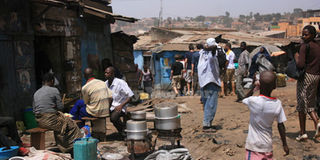Covid-19 forces 300,000 Ugandans into poverty

Covid-19 has seen a number of Ugandans lose jobs and incomes. PHOTO/FILE
What you need to know:
- The number of poor Ugandans has increased from eight million to 8.3m people with majority of these living in Busoga, Bukedi and Acholi sub-region.
Covid-19 forced at least 300,000 Ugandans into poverty, according to the Uganda National Household Survey, 2019/20.
The survey, conducted by Uganda Bureau of Statistics (Ubos), indicates that during the 2019/20 financial year income poverty, which also means living below the poverty line, worsened during Covid-19, increasing from 19 per cent to 22 per cent.
Covid-19 was first declared in Uganda in March 2020 and continues to ravage much of the country, causing loss of jobs and incomes.
The survey indicates that the number of poor Ugandans during the period increased from eight million to 8.3m people with majority of these living in Busoga, Bukedi and Acholi sub-region.
At 14 per cent, the Busoga sub region has the largest share of poor Ugandans, followed by Bukedi at 10.4 per cent and Acholi at 10.3 per cent.
However, poverty, according to the survey is still more profound in rural areas especially Karamoja, Acholi, Bukedi, and Busoga sub regions.
According to the survey, 65.7 per cent of people in Acholi sub region are now poor while 65.7 in Karamoja, 27.8 per cent in Lango and 23.4 per cent in Kigezi fall below the poverty line.
In Teso, 21 per cent of people in the sub region are poor compared to 20.4 per cent in 20.4 per cent in Busoga, 16 per cent in West Nile and 14 per cent in Bukedi.
In Buganda North, 13.8 per cent of people are considered poor compared to 13.2 per cent in Elgon and Ankole, 21.8 per cent in Tooro, 9.8 per cent in Bunyoro 6.9 per cent in Buganda South 6.9 and 1.6 per cent in Kampala.
However, the survey indicated the number of Ugandans in poverty had reduced to 20.3 per cent in 2020 from 21.4 per cent in 2017. Poverty remains a big challenge in Uganda. According to the International Monetary Fund, has been worsened by Covid-19, which has reversed gains made during decades of wealth creation programmes.
The survey also noted a reduction in the number of households connected to electricity from 22 per cent in 2017 to 19 per cent.
No explanation has been provided. However, the survey noted a marked growth in the number of Ugandans connected on solar from 18 per cent in 2017 to 38 per cent.
This could be explained by the failure by government to bring down electricity tariffs, with a unit now retailing at an average of Shs700, which could be high for ordinary Ugandans.
The survey also noted that poverty in West Nile had during the period reduced from 35 per cent in 2017 to 17 per cent in 2020. Other regions where poverty reduced during the period included Bunyoro (from 17 per cent to 10 per cent), Teso (from 25 per cent to 22 period) while in Elgon, it had reduced from 35 per cent to 13 per cent.
In Bukedi, it reduced from 44 per cent to 35 per cent while in Busoga, South Buganda and Kampala it reduced to 29 per cent, 7 per cent and 2 per cent, respectively.
The survey also noted that the number of households in subsistence economy had increased from 3.3m to 3.5m with the number of households operating businesses registering a notable reduction, especially in urban areas, which reduced by 37 per cent due to Covid-19.
Regions where poverty rose (%)
Region 2020 2017
Acholi 68 33
Ankole 12 7
Karamoja 66 60
Lango 23 16
Kigezi 28 12
Tooro 13 11
N. Buganda 14 11
Call to govt
According to Dr Sarah Ssewanyana, the Economic Policy Research Centre executive director, it is time government implements policies created to eliminate poverty.
“These policies are put in place to alleviate poverty but most have been left to districts that are poorly funded,” she says.




